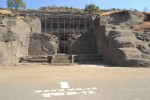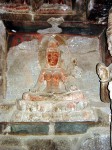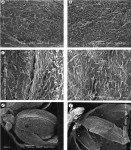 The Ellora Caves are monumental rock-cut cave monasteries about 20 miles to the northwest of Aurangabad city, Maharashtra, India. Carved from the 6th to the 11th century, there are caves dedicated to India’s three main religions: 12 Buddhist, six Jain and 17 Brahmanical. They are elaborate, multi-story structures carved into the mountain face that have living facilities for the monks — kitchens, bedrooms, living rooms — as well as shrines with sculptures of Buddha, bodhisattvas, Hindu deities and more. Frescoes decorate some of the walls and ceilings.
The Ellora Caves are monumental rock-cut cave monasteries about 20 miles to the northwest of Aurangabad city, Maharashtra, India. Carved from the 6th to the 11th century, there are caves dedicated to India’s three main religions: 12 Buddhist, six Jain and 17 Brahmanical. They are elaborate, multi-story structures carved into the mountain face that have living facilities for the monks — kitchens, bedrooms, living rooms — as well as shrines with sculptures of Buddha, bodhisattvas, Hindu deities and more. Frescoes decorate some of the walls and ceilings.
 The Buddhist caves were built between 630 and 700 A.D.; Caves 11 and 12 were the last ones made. Cave no. 12 is a three-story structure with a shrine inside. A sculpture of Buddha on a lotus throne surrounded by attendants presides over the shrine, while on the third floor is a small shrine to a goddess (goddess imagery was popular during the heyday of Esoteric Buddhism) with surviving polychrome paint on her face, body and in the background. The ceilings and walls are painted with floral and geometric designs. There has been some fading and paint loss caused by candle soot and the weather because the caves have been open to the elements for close to 1,500 years, but considering their age and the extremes of heat and moisture they’ve been subject to, it’s amazing the wall paintings survive at all. It’s largely due to the durability of the clay plaster underpinning the art.
The Buddhist caves were built between 630 and 700 A.D.; Caves 11 and 12 were the last ones made. Cave no. 12 is a three-story structure with a shrine inside. A sculpture of Buddha on a lotus throne surrounded by attendants presides over the shrine, while on the third floor is a small shrine to a goddess (goddess imagery was popular during the heyday of Esoteric Buddhism) with surviving polychrome paint on her face, body and in the background. The ceilings and walls are painted with floral and geometric designs. There has been some fading and paint loss caused by candle soot and the weather because the caves have been open to the elements for close to 1,500 years, but considering their age and the extremes of heat and moisture they’ve been subject to, it’s amazing the wall paintings survive at all. It’s largely due to the durability of the clay plaster underpinning the art.
 Manager Rajdeo Singh, of the Archaeological Survey of India’s science branch and M. M. Sardesai, botany professor at Dr. Babasaheb Ambedkar Marathwada University, teamed up to study the composition of the clay plaster inside Cave no. 12. They took samples from walls and studied them using a scanning electron microscope (SEM), a light microscope, a stereomicroscope and Fourier transform infrared spectroscopy (FTIR). They found Cannabis sativa fibers, pounded shoots, leaf fragments and even one bud. The plaster is composed of about 10% cannabis.
Manager Rajdeo Singh, of the Archaeological Survey of India’s science branch and M. M. Sardesai, botany professor at Dr. Babasaheb Ambedkar Marathwada University, teamed up to study the composition of the clay plaster inside Cave no. 12. They took samples from walls and studied them using a scanning electron microscope (SEM), a light microscope, a stereomicroscope and Fourier transform infrared spectroscopy (FTIR). They found Cannabis sativa fibers, pounded shoots, leaf fragments and even one bud. The plaster is composed of about 10% cannabis.
Hemp cultivation in India goes back to 5,000-4,000 B.C. Its stem fibers were used to make rope, its seeds to make oils, its resinous buds for medical and religious purposes and for fun. Ancient texts recommended it for the treatment of phlegm, flatulence, memory loss, gonorrhea and appetite loss. Cannabis was also used in construction. A combination of hemp hurds, lime and clay make a concrete-like substance known as hempcrete. Hemp fibers are acid free, resistant to insects, rodents, fungi and weeds. The long, durable fibers of Cannabis sativa are ideal for industrial use. They provide a great deal of strength in very little weight and density. Hempcrete is thermally stable, fire resistant, dampens sound and resistant to UV rays.
Studies in Europe have found that hempcrete walls have an estimated lifespan of 600-800 years before the fibers begin to deteriorate, but the Ellora plaster has more than doubled the low estimate even though environmental conditions are so adverse to the preservation of clay plaster and organic material. It’s hot in the summer and deluged with moisture during the rainy season, unlike the Mogao Caves in China which have been so well preserved by the desert climate.
The Ellora study recorded the temperature and relative humidity inside and outside Cave 12. The researchers found that the temperature inside the cave is stable between 78F and 81F while outside the temperature fluctuates between 64F and 90F. The stability inside the cave is due to hempcrete’s outstanding insulating abilities. Relative humidity, on the other hand, fluctuates less on the inside than the outside, but has a much wider range than the temperature: 27% to 45% inside, 25% to 55% outside. That’s why the plaster and paint still flakes on the inside. Even hempcrete can’t defeat the rainy season in Maharashtra.
There’s an example of what might have happened to the Ellora caves had their builders not used hempcrete. The Ajanta caves are 30 rock-cut structures dating from the 2nd century B.C. to the 5th or 7th century A.D. also in the Maharashtra region. Insects have had a field day with the paintings on the walls of the Ajanta caves. Fully a quarter of them have been devoured. The cannabis in the plaster at Ellora saved the caves from sharing Ajanta’s fate.
The study has been published in the March 10th issue of the journal Current Science and can be read here (pdf).
Cannabis is a wonder plant, God’s gift to mankind, it has so many different beneficial and positive uses. Among other uses, some leading car makers use cannabis plastic in their cars’ bodywork – it is stronger than steel and considerably lighter.
It’s sad to see a country like India, with thousands and thousands of years of understanding on the many uses of cannabis, turning to prohibitionism so extreme that even industrial uses are deemed “too dangerous” because they might result in someone smoking some weed. From the linked article in the second paragraph:
I wonder how this would benefit construction of cob houses? or stucco covered adobe? What about using it for paving material? I’m sensing a new sustainable housing product…
Like Vera said, cannabis construction materials are very much alive and well today. The plant itself is very easy to grow sustainably; it even adds nutrients to the soil, unlike most crops. Then once it’s integrated into hempcrete or other materials it’s lightweight, strong, naturally insulating and, believe it or not, actually absorbs carbon dioxide, so it’s pretty much a dream product for sustainable housing.
@Emily – to cut a very long link short, see http://tinyurl.com/z7bd3k5
Emily, do a Google search for “cannabis construction materials”, you’ll find a great deal of information.
Comments with links in them go to moderation so I can block spammers, Vera. As soon as I saw yours, I approved it. 🙂
Religion is Sativa for the Masses,
or was it the other way round ?
“You are laminated, and with this I gonna build my church,
Whatever you bind on earth will be bound in heaven.”
As good a read on pi day as it would have been on high day.
Cheers.
Thank you, so much! I had no idea! What possibilities! (My user name shall now be “Late to the Party”.)
I do not understand this…
The Ellora complex, at least the ones shown to tourists, is a completely rock-cut structure. What “plaster” are we talking about here?